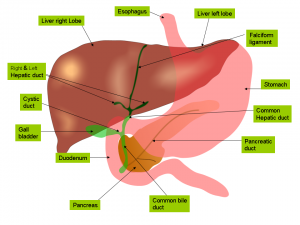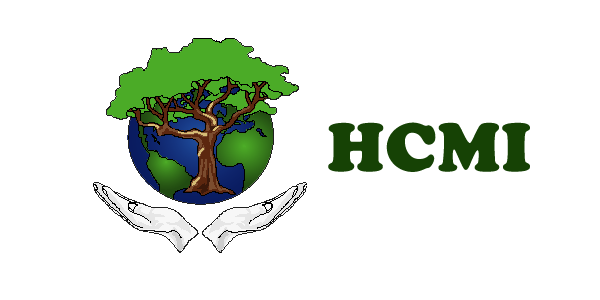 The liver, the largest internal organ, is located in the upper right and central portion of the abdominal cavity, just below the diaphragm. It is partially surrounded by the ribs, and extends from the level of the fifth intercostal space to the lower margin of the ribs. This means it is on the right side of the rib cage in the front, under the last couple of ribs. The liver releases its bile secretion into hepatic ducts, which eventually form the common bile duct and empty into the duodenum of the small intestine through the hepatopancreatic sphincter shared by the pancreas. The liver’s primary task is to filter all the chemicals and poisons out of the blood and to make bile. The gallbladder is a small sac that holds the bile and releases it when needed.
The liver, the largest internal organ, is located in the upper right and central portion of the abdominal cavity, just below the diaphragm. It is partially surrounded by the ribs, and extends from the level of the fifth intercostal space to the lower margin of the ribs. This means it is on the right side of the rib cage in the front, under the last couple of ribs. The liver releases its bile secretion into hepatic ducts, which eventually form the common bile duct and empty into the duodenum of the small intestine through the hepatopancreatic sphincter shared by the pancreas. The liver’s primary task is to filter all the chemicals and poisons out of the blood and to make bile. The gallbladder is a small sac that holds the bile and releases it when needed.
Sugar metabolism (energy)
When you studied the function of the pancreas a few pages back, you learned that the pancreas makes insulin and glucagons, each having an opposite effect on the liver. Insulin stimulates the liver to convert glucose (blood sugar) into glycogen (storable sugar), while glucagon stimulates the liver into converting glycogen (stored sugar) into glucose (available sugar in the blood). In other words, glucose is energy, and your liver is pretty much in charge of the amount of energy you have because it regulates how much is released into the blood and how much is stored. Yes, the pancreas has the duty of releasing the hormones needed to signal the liver to release energy, but if the liver is too full of chemicals and preservatives, its cells are too congested to get the job done. Because the liver stores extra sugar (glucose) as glycogen, it is always ready to give you a boost if the cells are healthy enough to respond. In addition, the liver stores iron and B-12, which are also energy-boosting elements. The hepatic cells in the liver are responsible for all these tasks.
Lipid (fat) metabolism
The liver oxidizes (burns) fats to make energy, synthesizes lipoprotiens, phospholipids and cholesterol; converts portions of carbohydrate and protein molecules into fat molecules for long-term energy (especially when stimulated by glucagons). Most of this is done with bile, a yellowish-green liquid that hepatic cells secrete continuously. Hepatic cells use cholesterol to produce bile and in secretion release cholesterol in the bile. In addition to water, bile contains bile salts, bile pigments, cholesterol and electrolytes. Bile salts are the most abundant of these. Bile salt aids digestive enzymes and enhance absorption of fatty acids and certain fat soluble vitamins and emulsify or break up fat globules so lipases can work on them more effectively. Bile salts also work to absorb cholesterol and vitamins A, D, E and K. Bile salts are reabsorbed in the small intestine and carried to the liver where they are re-secreted by hepatic cells. If any bile salts were lost in the feces, the liver makes more to replace them. Bile pigments (bilirubin and biliverdin) are breakdown products of hemoglobin from red blood cells. These are waste products from red blood cells that have been eaten by macrophages (a white blood cell) so that new ones can be created. The body is supposed to replace each red blood cell every 120 days. This is a natural process; it is not negative. The problem is, the liver is responsible for recycling trillions of them every day! The body only recycles the pigment, not the iron or nutrients; they are reserved for new red blood cells or for use in bile production. These pigments are normally excreted in the bile. An excess amount of bile pigment is what gives a person jaundice, the yellow-colored skin, and turns the whites of the eyes yellow. The liver synthesizes alpha and beta globulins to transport fat to the cells.
NOTE: The first year the medical system promoted cholesterol testing, they made 14 million dollars, so the importance of the test was immediately seen. The fact is, most livers naturally make more cholesterol every day than we consume. The body is supposed to make about 800 mg of cholesterol each day and be healthy. What people don’t realize, including the medical people, is that the amount of fat is not nearly as important as the kind of fat we eat. The body actually needs fat to survive and accomplish all of its tasks. Did you know that the body makes more cholesterol naturally each day than most people eat? The body need cholesterol for the production of essential bile. People living on low-fat foods are slowly headed for heart attacks and nervous breakdowns because they are not getting enough fat to keep the nerves healthy. The problem is not that we eat fat – it is the kind of fat we eat. Even more than the kind of fat we are eating, the liver and gallbladder are responsible for breaking the fat down to a usable format. How many people still have a gallbladder today? How many people have a healthy liver? The gallbladder isn’t even the key. It is nothing but a sack that holds bile, and the body grows a new one in many cases anyway. The liver is the organ responsible for making the bile, and most people have congested or dysfunctional livers. It’s a good thing the liver can regenerate itself, or we would all be in very serious condition. If you read the section that describes fats, carbohydrates and proteins at the beginning of the workbook, you will get a better understanding of fat and how it needs a balanced ratio of carbohydrates and proteins to be balanced. Just remember that low-fat diets are not good, but animal fat and saturated fat are the fats that create and contribute to high levels of cholesterol and liver congestion.
Protein metabolism
The liver’s primary tasks are probably those related to protein metabolism. I know people are extremely worried about eating enough protein and a previous section explains how 30 grams of protein each day is plenty, unlike the currently accepted 70 gram figure. The truth is, protein is very essential for every aspect of health, but the body was designed to live primarily on complex carbohydrates, and proof of that is the liver’s ability to make amino acids from carbohydrates. Isn’t that amazing? Your liver is phenomenal and the most complex metabolic organ in the body. You don’t have to eat excess protein; simply eat the right kinds of carbohydrates, and the liver will convert them into amino acids.
NOTE: Bile also acts as an antiseptic and a natural laxative creating peristalsis in the intestine. Most laxative herbs are cholagogues, meaning they induce bile production! When you take them you just need to drink enough water so the body can make the electrolytes needed to balance it as too much bile can cause diarrhea and dehydration. Enough water in the system will fix that, though.
Eyes and the liver
The eyes are an absolute reflection of the health of the liver and the hepatic system. Does this mean that the health of the eyes is primarily dependent on the health of the liver? That is absolutely correct. Treatment of the eye should begin with treatment of the liver. It is not to say that bacteria, viruses and other microorganisms cannot become hosted in the eye, but if the liver is strong, the eyes will be strong enough to fight off the invading organisms. Even in the case of accident or trauma, the liver governs the ability and speed of the eyes to heal and regenerate.
Suggestions to strengthen the liver
- Eat less animal protein and more plant protein (green vegetables).
- Eat more complex carbohydrates.
- Make sure digestion and assimilation are healthy.
- Focus on happy things.
